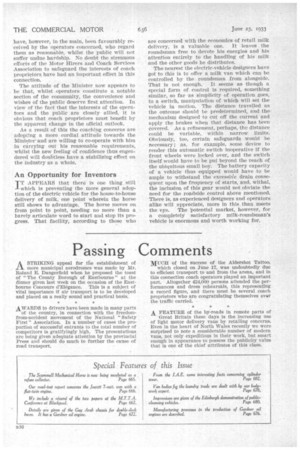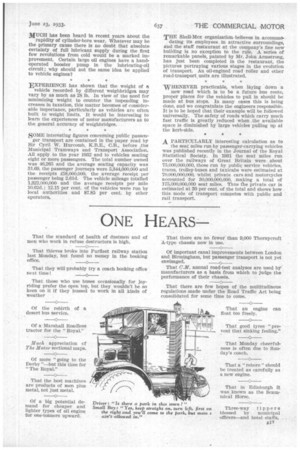Passing Comments
Page 30

Page 31

If you've noticed an error in this article please click here to report it so we can fix it.
ASTRIKING appeal for the establishment of more municipal aerodromes was made by Mr. Roland E. Dangertield when he proposed the toast of "The County Borough of Eastbourne" at the dinner given last week on the occasion of the Eastbourne Concours d'Elegance. This is a subject of vital importance if air transport is to be developed and placed on a really sound and practical basis.
AWARDS to drivers have been made in many parts
of the country, in connection with the freedomfrom-accident movement of the National " Safety First" Association. In a number of cases the proportion of successful entrants to the total number of competitors is gratifyingly high. The presentations are being given adequate attention by the provincial Press and should do much to further the cause of road transport. MUCH of the success of the Aldershot Tattoo, which closed on June 17, was undoubtedly due to efficient transport to and from the arena, and in this connection coach operators played an important part. Altogether 424,000 persons attended the performances and dress rehearsals, this representing a record figure, and there must be several coach proprietors who are congratulating themselves over the traffic carried.
A FEATURE of the by-roads in remote parts of
Great Britain these days is the increasing use of light motor delivery vans by retailing concerns. Even in the heart of North Wales recently we were surprised 0 note a considerable number of modern vans, not only expeditious in their work. but smart enough in appearance to possess the publicity value that is one of the chief attributes of this class.
MUCH has been heard in recent years about the
rapidity of cylinder-bore wear. Whatever may be the primary cause there is no doubt that absolute certainty of full lubricant supply during the first few revolutions from cold would be a marked improvement. Certain large oil engines have a handoperated booster pump in the lubricating-oil circuit ; why should not the same idea be applied to vehicle engines?
EXPERIENCE has shown that the weight of a
vehicle recorded by different weighbridges may vary by as much as 28 lb. In view of the need for minimizing weight to counter the impending increases in taxation, this matter becomes of considerable importance, particularly as vehicles are often built to weight limits. It would be interesting to learn the experiences of motor manufacturers as to the general accuracy of weighbridges.
SOME interesting figures concerning public passen ger transport are contained in the paper read by Sir Cyril W. Hurcomb, K.B.E., C.B., before the Municipal Tramways and Transport Association. All apply to the year 1932 and to vehicles seating eight or more passengers. The total number owned was 46,265 and the average seating capacity was 31.69, the passenger journeys were 5,344,000,000 and the receipts 08,000,000, the average receipt per passenger being 2.61d. The vehicle mileage totalled 1,322,000,000 and the average receipts per mile 10.82d.; 12.15 per cent. of the vehicles were run by local authorities and 87.85 per cent, by other operators. THE Shell-Mex organization believes in accomme
dating its employees in attractive surroundings, and the staff restaurant at the company's fine new building is no exception to the rule. A "series of remarkable panels, painted by Mr. John Armstrong, has just been completed in the restaurant, the pictures portraying various stages in the evolution of transport. An oil-engined road roller and other road-transport. units are illustrated.
WHENEVER practicable, when laying down a new road which is to be a future bus route, proper places for the vehicles to pull in should be made at bus stops. In many cases this is being done, and we congratulate the engineers responsible. It is to be hoped that their example will be followed universally. The safety of roads which carry much fast traffic is greatly reduced when the available space is diminished by large vehicles pulling up at the kerb-side.
A PARTICULARLY interesting calculation as to
the seat miles run by passenger-carrying vehicles was published recently in the Journal of the Royal Statistical Society. In 1931 the seat miles run over the railways of Great Britain were about 75,000,000,000, those run by public service vehicles, trams, trolley-buses and taxicabs were estimated at 70,000,000,000, whilst private cars and motorcycles accounted for 30,000,000,000, making a total of 175,000,000,000 seat miles. Thus Ole private car is estimated at 30 per cent, of the total and shows how this mode of transport competes with public and rail transport.




























































































